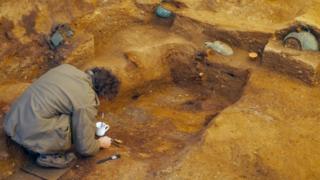Secrets of Southend's 'King of Bling' revealed
 Image copyright
Mola
Image copyright
Mola
A royal burial site found between a pub and Aldi supermarket has been hailed as the UK's answer to Tutankhamun's tomb.
Workmen unearthed the grave, which contained human remains and exotic artefacts, during road-widening works in Prittlewell, near Southend, Essex, in 2003.
Experts believe its occupant was Seaxa, a brother of 6th Century Anglo-Saxon king Saebert.
The site is thought to be the earliest example of its kind.
Archaeologists said golden foil crosses found inside suggested the grave belonged to an early Christian.
The burial chamber, which was about 13ft (4m) square and 5ft (1.5m) deep, contained some 40 artefacts.
Among them was a lyre and a 1,400-year-old box thought to be the only surviving example of painted Anglo-Saxon woodwork in Britain.
Gold coins, the gilded silver neck of a wooden drinking vessel, decorative glass beakers and a flagon believed to have come from Syria were also found.
The valuable collection, and presence of artefacts from other kingdoms, earned the grave's unknown occupant the nicknames Prince of Prittlewell and the King of Bling.
'Hairy beast Saxon warrior'
It had been thought the remains were those of King Saebert.
But carbon dating on fragments of tooth enamel has indicated the man inside died at least 11 years before the king met his end.
Archaeologists said the size of the coffin, and placement of items within it, suggested he was about 5ft 6in (1.68m) tall.
Sophie Jackson, from the Museum of London Archaeology (MOLA), said "the best guess" was that the tomb had housed the king's brother, Seaxa.
She said: "There's a lot of debate about whether he was a fully-fledged hairy beast Saxon warrior, or younger.
"Had he died before he could really prove himself?
Ms Jackson said the grave provided a snapshot of a "really interesting time" when Christianity was "just creeping in" to the British Isles.
"They would have been just on the transition between having pagan burials with all your gear but also having these crosses," she said.
Ms Jackson, the museum's director of research and engagement, said no-one had expected the "unpromising looking site" to contain "our equivalent of Tutankhamun's tomb".
"It's between a bit of railway and a bit of road, essentially a verge. It's not where you'd expect to find it," she said.
Some of the recovered artefacts will be displayed at Central Museum in Southend from Saturday.
The museum has also launched a website with information about its research, as well as an interactive diagram of the tomb.